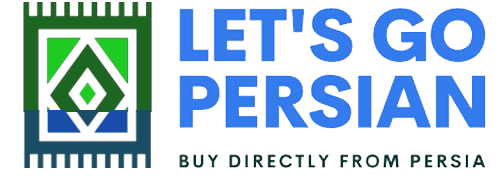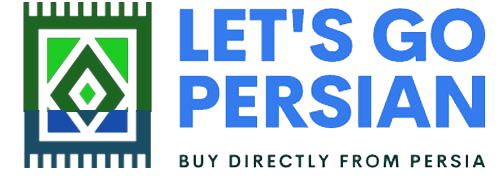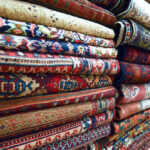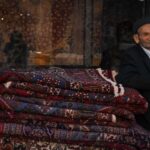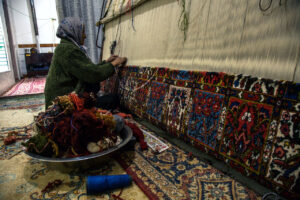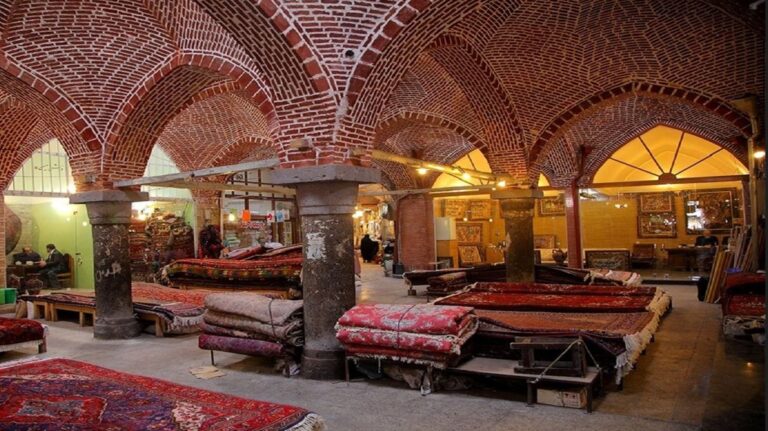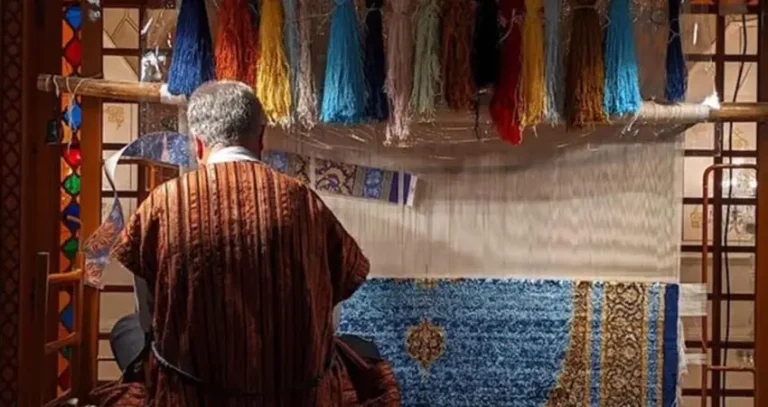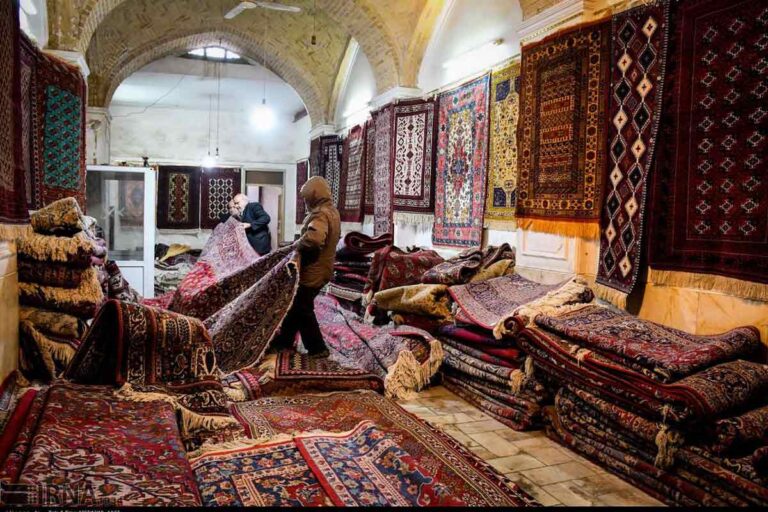Gol-e Farang: A Floral Motif with European Roots in Persian Carpets
Persian vs. Turkish Knot in Handwoven Carpets
Walk through any carpet bazaar in Iran and you’ll notice something remarkable: two seemingly similar carpets can differ in price by a factor of 100—or more—per square meter. This vast pricing range often leaves newcomers confused, but it’s not arbitrary. The value of a handwoven Persian carpet is influenced by a combination of interrelated factors, each carrying different weight depending on the rug’s origin, condition, and features.
This post breaks down some of the key criteria used in the valuation of handwoven carpets, offering insights into why two rugs may look alike but have vastly different price tags.
1. New, Used, or Antique?
One of the most basic factors is the carpet’s age:
-
New rugs are typically more expensive than similar used ones.
-
However, antique carpets—typically over 70–80 years old—can far exceed the price of their new counterparts, provided they meet certain criteria like uniqueness, historical relevance, or artistic value.
Antique carpets are often sought after by collectors and museums, adding not just material but cultural value to the piece.
2. Condition and Preservation
For used or older carpets, physical condition is critical:
-
Wear and tear: Worn-out pile, faded colors, or weakened foundation reduce value.
-
Restoration: Presence of repairs (reweaving, patching, replaced fringes) can either enhance or lower the price, depending on quality.
-
Originality: Carpets with untouched, original fringes and minimal restoration typically command higher prices.
Subtle signs of damage like dry rot or threadbare areas significantly affect value—particularly if located in the carpet’s central field or medallion.
3. Raw Materials Used
The quality and type of materials play a huge role in determining the rug’s price:
-
Wool, silk, and cotton (used for the warp/weft) vary greatly in quality and cost.
-
High-grade silk is more expensive and luxurious than lower grades or synthetic blends.
-
Naturally dyed yarns command higher value than those using synthetic dyes, due to the labor-intensive process and better aging.
Handspun yarns, particularly handspun wool, also increase the final cost because of their texture, sheen, and irregular charm.
4. Brand and Signature
Like fine art, some carpets carry the signature—or reputation—of renowned weavers or workshops. A rug associated with a master artist or a famous weaving center (like “Seirafian of Isfahan” or “Habibian of Nain”) can dramatically increase its market value.
Collectors often treat these names like brands, adding a layer of prestige and authenticity to the piece.
5. Urban, Rural, or Nomadic Origin
Generally (though not always), urban-made carpets are more expensive. Here’s why:
-
Urban carpets are produced in organized workshops, under strict supervision, ensuring uniform design, high knot density, and consistency.
-
Village and tribal rugs are made in smaller quantities, often on portable looms, with a more spontaneous approach. While rich in charm and tradition, they may have irregularities (e.g., asymmetry, color bleeding, or knot inconsistencies).
That said, nomadic rugs may also become valuable based on their age, rarity, or cultural uniqueness.
6. Type and Quality of Weaving
Not all knots are created equal. Persian carpets can be woven using different techniques, the most notable being:
-
Turkish (Symmetrical) Knot
-
Persian (Asymmetrical or Senneh) Knot
-
Double Knot (Jufti)
Some knots are more complex and time-consuming to tie than others, directly impacting production time and labor cost. The cleanliness and consistency of the knots, along with the skill level of the weaver (amateur vs. master), are also important indicators of quality.
7. Knot Density (Fine vs. Coarse Weaving)
Knot density refers to the number of knots per unit area and is a key determinant of price:
-
In cities like Tabriz, the “Raj” unit is used, which counts knots across 7 cm of the rug’s width.
-
For example, a “40 Raj” rug has about 40 knots per 7 cm, translating to a high knot density.
International standards may use knots per square meter or per square decimeter. Finer weaves require more time, precision, and higher-grade materials, making them significantly more valuable.
8. Weaving Defects
Certain imperfections reduce the value of a rug, including:
-
Color striping (regeh): Uneven dye batches causing shades of the same color to vary.
-
Skewing or asymmetry: Visible distortions in normally symmetrical patterns.
-
Misweaving (glat-bafi): Deviations from the original design.
-
Off-center medallions: Medallion not perfectly aligned in the rug’s center.
While some of these defects may be corrected post-weaving (e.g., with tensioning or “dar-keshi”), others remain permanent and negatively impact value.
9. Post-Weaving Damage
A rug may be damaged after weaving during processes like:
-
Washing: Poor dye fixation can cause bleeding, especially from dark to light areas.
-
Shearing (pile trimming): Uneven trimming can result in surface dips or patches.
Such flaws are often penalized in valuation and decrease the carpet’s appeal.
10. Supply and Demand
As with any market, trends and consumer preferences can significantly influence pricing. Certain styles, designs, or color combinations may be in high demand at specific times due to:
-
Interior design trends
-
Shifts in consumer tastes
-
Economic conditions
Increased demand for specific styles leads to higher prices, even for rugs with average technical specifications.
11. Size and Dimensions
Larger carpets are more expensive per square meter for two key reasons:
-
Longer production time, leading to higher labor and capital costs.
-
Lower supply, as fewer workshops or artisans have the capacity to produce them.
Rugs with non-standard or rare sizes may also attract premium pricing, depending on buyer needs.
12. Place of Origin
The city or region where the carpet is woven often carries historical weight. Cities like:
-
Tabriz
-
Isfahan
-
Qom
…are synonymous with high-quality carpet craftsmanship. Buyers are often willing to pay a premium for carpets carrying these labels due to:
-
Superior weaving precision
-
Prestige of the region
-
More skilled labor and higher production costs
For example, two identical designs made in Bijar and Zanjan may be priced differently, with the Bijar version often commanding more due to its reputation.
Final Thoughts
From technical weaving quality to regional reputation and market demand, many subtle and interconnected factors influence the price of a handwoven Persian carpet. Understanding these elements helps buyers make informed decisions and appreciate the true value behind every handmade piece.
Pricing a Persian carpet is a nuanced process that goes beyond surface beauty. From material quality to knot count, from historical relevance to artistic signature—each element plays a role in determining the final value. Understanding these can help buyers make informed decisions and better appreciate the craftsmanship behind each rug.
